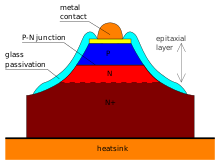Varactor diode

Internal structure of a varicap
|
|
| Type | Passive |
|---|---|
| Pin configuration | anode and cathode |
| Electronic symbol | |
 |
|
In electronics, a varicap diode, varactor diode, variable capacitance diode, variable reactance diode or tuning diode is a type of diode designed to exploit the voltage-dependent capacitance of a reversed-biased p–n junction.
Varactors are used as voltage-controlled capacitors. They are commonly used in voltage-controlled oscillators, parametric amplifiers, and frequency multipliers. Voltage-controlled oscillators have many applications such as frequency modulation for FM transmitters and phase-locked loops. Phase-locked loops are used for the frequency synthesizers that tune many radios, television sets, and cellular telephones.
The varicap was developed by the Pacific Semiconductor subsidiary of the Ramo Wooldridge Corporation who received a patent for the device in June 1961. The device name was also trademarked as the "Varicap" by TRW Semiconductors, the successor to Pacific Semiconductors, in October 1967. This helps explain the different names for the device as it came into use.
Varactors are operated in a reverse-biased state, so no DC current flows through the device. The amount of reverse bias controls the thickness of the depletion zone and therefore the varactor's junction capacitance. Generally, the depletion region thickness is proportional to the square root of the applied voltage, and capacitance is inversely proportional to the depletion region thickness. Thus, the capacitance is inversely proportional to the square root of applied voltage.
All diodes exhibit this variable junction capacitance, but varactors are manufactured to exploit the effect and increase the capacitance variation.
...
Wikipedia
